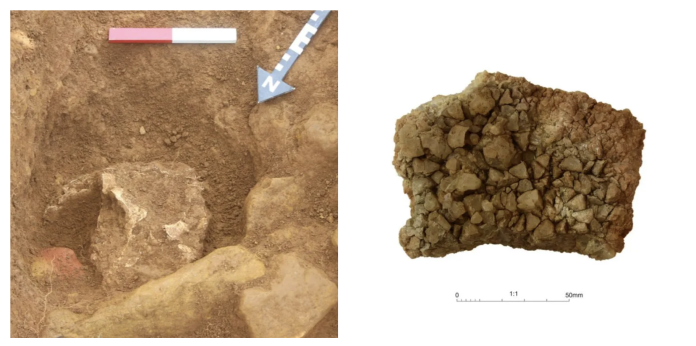Cattle skull and cluster of quartz crystals found in a Roman enclosure at Broken Furrow
In the spring of 2021, the Milton Keynes Cotswolds Archaeology team undertook an excavation at ‘Broken Furrow’ for Orion Heritage and Kendrick Homes Ltd. The site was situated on the northern edge of Hardwick, a suburb of Banbury in Oxfordshire. The remains of a series of Late Iron Age to Early Roman livestock enclosures were revealed, which showed evidence for repeated maintenance and changes to their layouts. It may be that these ditches were prone to filling in quickly – you might be surprised how quickly a dug feature fills back in!
Roman enclosures are common to find in Oxfordshire, but slightly unusual was a cattle skull that had been deposited upside down in one of the ditches, accompanied by a fragment of quartz crystals. The skull had actually been placed in one of the enclosure ditches after it had been cleaned out, and may have formed a ‘foundation’ or ‘structured’ deposit’; these are special deposits used to mark important events. In this case, the objects may have been used to celebrate the re-establishment of the enclosure or ditch, potentially following a renewed focus on cattle management.
The association of the skull with a natural crystal cluster also ties in with the potential for ritual activities. Quartz often features in prehistoric mortuary settings and, although no Iron Age parallels are known in the local area, the inclusion of the crystals in association with this cattle skull could form a deliberate deposition. The quartz crystals had been identified as ‘non-local’, indicating they were potentially viewed as exotic items imported to the site. Some believe that due to its colour, the white of quartz has been associated with purity, peace, and even human bone! Therefore, the deposition of the crystals alongside the cattle skull was potentially linked to religious or superstitious beliefs, and possibly also linked to the agricultural potential of the enclosures and wider pastoral landscape.
No compelling evidence for domestic occupation was identified at the site and it is likely that the main focus of the settlement was located elsewhere in the surrounding landscape, maybe to the north where further contemporary enclosures and crop-drying ovens were found during previous archaeological excavations. The two groups of pits and postholes situated in the interior of the enclosures are more likely to have been related to livestock pens or fences, rather than domestic structures.
One of the few domestic objects we did find was a stunning penannular brooch, recovered by Nicole from one of the enclosure ditches. We wonder how this brooch found itself in an agricultural enclosure ditch… Could it have been lost by an unlucky farmer? Or perhaps, like the cattle skull, it was left as a votive offering..?
From : Finds from the Roman enclosure at Broken Furrow – Cotswold Archaeology
by Grace Griffith
Publications Officer



